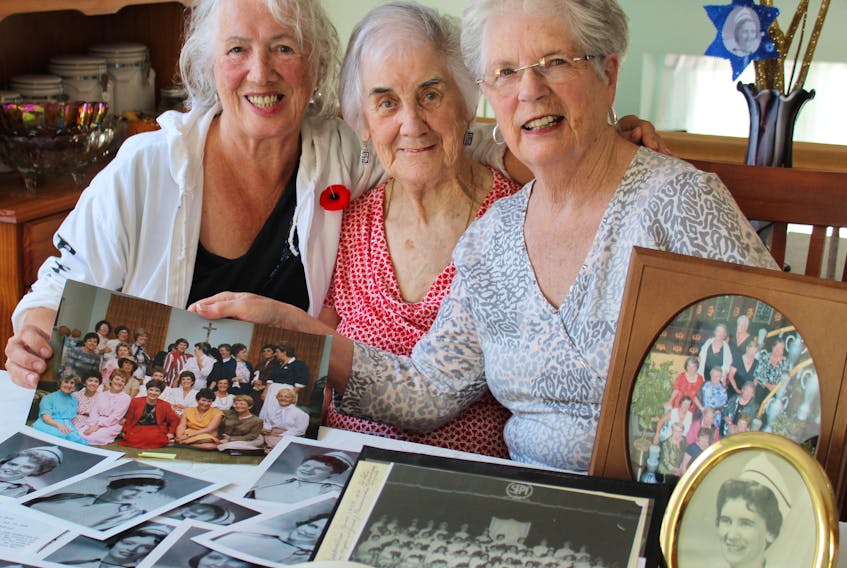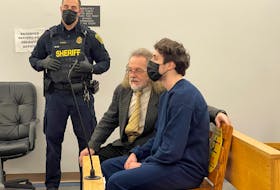ST. JOHN'S, N.L. — They were hesitant to spill the beans on the St. Clare’s chocolate cake caper.
“The one we can’t talk about probably when we sent the orderly down the dumb waiter,” said Maureen Fahey, glancing at Mary Keiley and Joan Byrne as they reminisced around Keiley’s kitchen table.
They’d been asked to share some anecdotes from their time at the St. Clare’s school of nursing, from which they graduated in 1959.
They talked with admiration and high praise of the Sisters of Mercy nuns who ran the school — calling them saints for their dedication to patients and the poor. But, like any nursing school of its era, it was run with strict rules that had consequences when disobeyed.
“There’s no one to get you in trouble,” urges The Telegram reporter, pointing out the statute of limitations has long passed on the youthful hijinks.

And then with a good-natured round of laughter, the stories rolled out with the kind of vivid detail that puts the listener on the scene.
But before we tell that story, know that these women and their classmates have been reminiscing together and sharing their life stories for decades — sometimes in small gatherings when at someone’s home for a visit, and at special reunions — their 20th, 25th and 30th, and a cruise on their 50th. This year, it’s their 60th and 16 members will gather again in St. John’s for four days starting Saturday. They’ll have Jigg’s dinner, followed by a visit to St. Clare’s on Sunday, attendance at the annual St. Clare’s nursing school alumni dinner — the association celebrates its 75th anniversary this year — and on the last night, a party with musical guests.
“It’s going to be a great time,” Fahey said.
“It’s going to be a shindig,” Keiley agreed, noting the Class of ’59 is renowned for its closeness.
“It is noticed by many people we were so cohesive. We all kept in touch.”
“We’re all good friends,” said Fahey.
Now in their 80s, some can’t attend for health reasons — either their own or their spouse’s.
And from a tree of gold branches hang cloth stars with graduation photos of the 12 who have passed on. It will be carried with honour to each event.
Back when it all began for them, occupations for women were limited.
“You only could be a teacher, nurse or secretary in our day,” Fahey recalled.
“I was always interested in people. That’s why I went into nursing,” said Byrne.
When they stepped through the doors of St. Clare’s three years before their graduation, the hospital had a ramshackle residence — back then nursing schools required students to live in.
It was infested with mice.
“The mice would get under our pillow and if you had a bar, they ate it. It happened to me,” Keiley said.
In 1958, it was torn down and a new residence — Our Lady of Lourdes Hall — opened. A wing is still part of the hospital, although the school of nursing is long gone — as hospital-run training schools were phased out and university bachelor’s degrees became mandatory for registered nurses.
They had a 10:30 p.m. curfew. If they failed to make it or broke other rules, they might lose privileges or their one day off per week.
Fahey, who was from Pleasant Street, had many friends in the city, some of whom went to Memorial University, then on Parade Street.
“We used to go swimming in the summer out at Topsail Pond. Someone always had to leave and drive me back for 10:30. It drove me crazy,” she said.
One of the rules involved the overnight shift, when the young nurses had to work straight through their required eight hours on the floor.
Day shifters got a mid-day meal in the dining room, and there was an 11 p.m. supper for those on the overnight shift. But it was unappetizing leftovers from lunch.
So, they devised ways to get snacks. Sometimes it was a can of SpaghettiOs from the pediatrics floor, on hand there for fussy eaters. Sometimes it was fudge made from the milk and sugar kept on each floor.
“There’s nowhere you would go to work for eight hours,” Fahey said.
“Without a bite to eat,” Keiley finished.
“And there was no nothing, no break.”

The nurses plotted for weeks on the chocolate cake caper and convinced a small-set male orderly to sneak down on the dumb waiter, and raid the nuns’ basement refrigerator for a chocolate cake. They devised a secret knock as the dumb waiter was called to each floor and nurses in on it took their slices.
“It had to be all synchronized,” said Fahey.
But when a nun appeared on one of the higher floors, the orderly was stuck in the dumb waiter — hiding in the cramped lift with the cake.
“When he finally got out, he said, ‘I’ll never, ever do anything for you guys again,’” Fahey said as they all roared with laughter at the memory.
“We were all hauled out of bed the next morning — when you are on nights and called back to report, you had to be in full uniform, the hat and cap and all lined up.”
“Who knows about this?” the nuns demanded of the missing cake.
“Zip, nobody said a word,” Fahey recalled, motioning how they stayed tight-lipped about the heist.
“Oh my gosh, they never found out.”
“But they knew it was us. It was the night-time residents,” theorized Keiley.
It was tradition for the students to pass stories on to the younger classes.
Many were warned of ghosts, made-up stories encouraged by the strange night noises of clunky equipment that mimicked footsteps in empty hallways.
One night, Byrne was working the nightshift on the third floor and heard loud moaning — and it wasn’t coming from any of her patients.
She went to investigate and found an open window, which carried the voice of someone in labour on the floor below.
“I was so relieved it wasn’t a ghost,” she said.
The conversation turned more serious as they shared stories of seeing accident victims in the morgue, of dealing with sick children.
And then the pride in their work, of getting their nursing caps, of a different way of nursing — their duties that required not only treating patients, but everything from emptying the trash to changing the sheets — bedside nursing they enjoyed.
“We had an exam in bed making,” Keiley said.
Their yearbook also depicts a St. John’s era long gone.
One ad boasts of the futuristic marvels — the early arrival of the 1965 new Philco Predicta television — the world’s first semi-flat picture tube with cluster front controls. It is several decades obsolete now, and The Royal Stores Ltd. is long shuttered.
Newfoundland Light and Power was advertising itself as the “symbol of cheap, reliable electricity,” a jarring notion now with the threat of sky-high bills to pay for Muskrat Falls.
Their first job as nurses paid roughly $200 per month.
It was a pittance compared to the five- to six-figure annual salaries of nurses today, but still a lot of money back then. Byrne managed to buy a car and a fur coat. It was a big raise from the $25-per-month stipend they had in the last training year.
When they graduated, they said, they could have had their pick of three jobs each.
“There was lots of work, lots of it. People were waiting for you to finish,” said Keiley, who went on to teach nursing for 30 years, and still volunteers on Saturdays washing patients’ hair. Margie Sheridan of Ottawa and Margaret Kavanagh of Huntsville, Ont., met up at Sheridan’s home to travel together to the reunion.
They also noted how close the classmates have remained through the years, with visits between those living on the mainland or with St. John’s friends when they go back home.
“You think, I have my health, I can afford to come, why don’t I come?” Kavanagh said in a phone interview as they prepared to leave.
“We kept in touch and that makes a big difference. When we would come home, I really wanted to see the girls.”
“It’s very important. We’ve always been in touch,” said Sheridan, who worked at a clinic in Montreal for 30 years before moving to Ottawa.
Of the 60 years that have passed, she said, “It’s only a number, isn’t it?”
Twitter: @BarbSweetTweets









